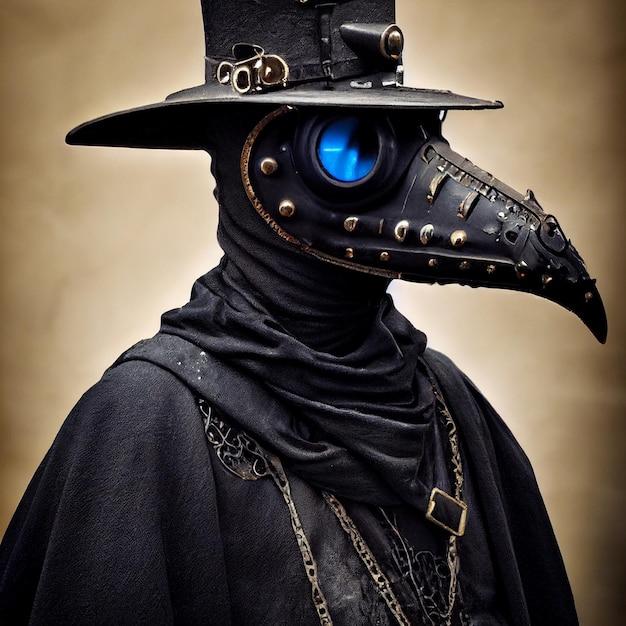The year is 2023, and the world has experienced its fair share of pandemics and outbreaks. As we reflect on history, one particular figure stands out – the mysterious and eerie figure of the plague doctor. Clad in a long black cloak, adorned with a wide-brimmed hat and a peculiar beaked mask, these doctors were tasked with treating patients during the infamous Black Death. But amidst the chaos and devastation of the plague, one burning question remains – did these plague doctors, who were in such close proximity to the deadly disease, themselves fall victim to its wrath?
In this blog post, we will delve into the world of plague doctors, exploring the origins of their intriguing attire, their historical significance, and uncovering whether they were able to escape the clutches of the plague. Join us as we journey through history to unravel the secrets surrounding these enigmatic figures and shed light on their role during one of the deadliest pandemics in human history.
Did Plague Doctors Get Sick
Throughout history, the role of the plague doctor has been an intriguing one. These mysterious figures, donning bird-like masks and eerie black robes, have captured the imaginations of many. But have you ever wondered, did plague doctors get sick themselves? Let’s delve into the nitty-gritty and separate fact from fiction.
The Curious Attire of Plague Doctors
Before we dive into the question of their health, let’s address the elephant in the room. If you were a plague doctor, your fashion sense would certainly be on point. Picture this: a long black robe to symbolize mourning, a wide-brimmed hat to shade you from the sun (and add a touch of mystery), and gloves to protect those delicate hands of yours. But the pièce de résistance? The infamous bird-like mask, complete with a prominent beak. Talk about making a fashion statement!
The “Preventative” Measures
Plague doctors were not just concerned with looking stylishly sinister; they believed in certain preventative measures to keep themselves safe. Their beaked masks were filled with aromatic herbs and spices, including juniper berries, myrrh, and cloves. These fragrant concoctions were thought to ward off miasma, the “bad air” believed to carry disease. Additionally, they carried canes to maintain distance from patients and to examine them from afar. Social distancing in the 17th century? Well, well, they were ahead of their time!
A Risky Business
Now, let’s unveil the truth: yes, plague doctors did get sick. Despite their best efforts, the risks they faced were considerably high. Their close proximity to patients, the inadequate understanding of contagious diseases during that era, and the lack of appropriate protective equipment all contributed to their vulnerability. It’s safe to say that being a plague doctor was not for the faint of heart!
The Toll of the Job
As you can imagine, the toll on their health was severe. Plague doctors were at a higher risk of contracting the very diseases they were trying to combat. Countless plague doctors lost their lives battling the Black Death and other epidemics. Their dedication to their cause cannot be denied, even if their understanding of disease prevention was lacking by today’s standards.
Lessons Learned
Despite their inability to fully protect themselves, plague doctors played a crucial role in history. Their efforts to alleviate suffering, provide medical treatment, and study diseases have paved the way for modern medicine. We owe a debt of gratitude to these brave individuals who risked their own health in the hope of saving others.
So, to answer the burning question, did plague doctors get sick? Yes, they did. While they may have looked eerie and remained dedicated to their cause, their noble efforts came at a great cost. Let’s remember their sacrifice and continue to push the boundaries of medical knowledge in their honor.
Now that we’ve uncovered the truth about plague doctors, let’s dive into more intriguing aspects of their profession! Stay tuned for the next captivating subtopic in our exploration of these enigmatic figures of history.
FAQ: Did Plague Doctors Get Sick
Welcome to our FAQ section, where we tackle some of the most burning questions about plague doctors and their susceptibility to the dreaded plague. We know you’ve got questions, and we’ve got answers!
Is Plague Doctor Evil
Contrary to popular belief, plague doctors were not evil villains lurking in the shadows. They were medical professionals who risked their lives to care for those afflicted by the plague. So, no, they were not evil, just incredibly brave and selfless.
Do Pandemics End
Yes, pandemics do eventually come to an end. The Black Death, the most infamous pandemic in history, eventually subsided. However, it’s important to note that pandemics are not always completely eradicated. Diseases like the flu continue to affect people each year, but thanks to advances in medicine, we can better manage and prevent their spread.
Is the Plague Airborne
Yes, the plague can indeed be transmitted through the air. The bacterium responsible for the Black Death, Yersinia pestis, can spread through respiratory droplets. It’s a chilling reminder of how easily diseases can be transmitted.
Who Created the Plague Mask
The credited inventor of the iconic plague mask is Charles de Lorme, a physician in France. He designed the mask in the 17th century, believing it would protect doctors from the “bad air” that was thought to carry the disease. Little did he know that his creation would become a symbol of the plague itself!
Did Plague Doctors Use Mercury
Yes, plague doctors did use mercury in their treatments. They believed it had healing properties and would protect them from the disease. However, we now know that mercury is highly toxic and would have likely caused more harm than good.
Is the Black Death Still Around
While the Black Death is no longer causing mass devastation like it did in the past, cases of the plague still exist today, albeit in much smaller numbers. Thanks to modern medicine and our understanding of the disease, it is now treatable with antibiotics.
Did Plague Doctors Get the Plague
Unfortunately, plague doctors were not immune to the disease they battled. They were constantly exposed to infected individuals and the contaminated environment, making them highly susceptible to contracting the plague themselves. Many plague doctors tragically lost their lives while attempting to save others.
How Many People Died from the Black Plague
The Black Death was a catastrophic event, claiming the lives of an estimated 75 to 200 million people across Europe and Asia. It wiped out a significant portion of the world’s population and left a lasting impact on history.
Did Plague Doctors Actually Help
Yes, despite the risks they faced, plague doctors played an important role in combating the plague. They provided medical aid, comforted the sick, and implemented preventive measures, such as quarantine and disinfection. Their efforts, although sometimes misguided by the limited medical knowledge of the time, undoubtedly saved lives.
What Did Plague Doctors Have in Their Beaks
Plague doctors’ beaks were not just a fashion statement. They served a practical purpose. These elongated masks were filled with aromatic substances, such as dried flowers, herbs, and spices. The strong smell was believed to ward off the “miasma” or “bad air” thought to carry the disease. Additionally, the beak-shaped design allowed for better communication while providing some protection.
Are Plague Nurses Real
While we often associate plague doctors with their distinctive appearance, there is little historical evidence of plague nurses. However, it is possible that some women also provided medical assistance during this time. Sadly, their contributions have been overshadowed by the iconic imagery of plague doctors.
How Did Plague Doctors Not Get Sick
Plague doctors took several precautions to minimize their risk of infection. Apart from their protective clothing and masks, they would often wear gloves and coats made of waxed fabric to prevent contact with bodily fluids. They would also frequently disinfect their masks and clothing with vinegar or other substances believed to kill the disease-causing agents.
Why Is the Black Death Called the Black Death
The term “Black Death” likely originated from the dark purplish or blackened skin patches that appeared on affected individuals. These patches were often accompanied by other gruesome symptoms, contributing to the ominous name.
Why Did Pope Clement Survive the Plague
Legend has it that Pope Clement VI, during the outbreak of the Black Death, protected himself from the disease by isolating himself in his quarters and burning fires infused with aromatic herbs. While it may seem like a stroke of luck, it’s important to note that not all precautions were available or effective during that time.
Who Was the Most Famous Plague Doctor
One of the most well-known plague doctors in history is Nostradamus. Before predicting the future, he worked as a physician and treated plague-infected patients. His knowledge and skills helped him gain recognition, but you won’t find him in the beaked mask he is often portrayed wearing.
What Is the Black Death Called Today
The Black Death is still commonly referred to as the Black Death. Historians, medical professionals, and curious minds alike continue to use this name to acknowledge the historical significance of one of the deadliest pandemics in human history.
How Did the Black Death End
The Black Death eventually ended because the number of susceptible individuals began to decline. After claiming the lives of millions, those who survived developed immunity or perished, limiting the spread of the disease. Additionally, improved sanitation and public health measures played a crucial role in preventing future outbreaks.
How Much Did Plague Doctors Get Paid
Plague doctors were often paid by towns or municipalities to care for the sick. However, their compensation varied greatly, ranging from modest sums to more generous payments. Given the risks they faced, it’s fair to say that their earnings should have been significantly higher.
When Did the Black Death End
The Black Death pandemic began in the 14th century and progressively subsided in the following years. While exact dates vary, historians generally agree that the worst of the outbreak occurred between 1347 and 1351. After this period, the frequency and severity of outbreaks significantly declined.
Did Anyone Survive the Black Death
Yes, there were survivors of the Black Death. Some individuals developed immunity or were lucky enough to avoid infection altogether. However, with mortality rates estimated to be between 30% and 75%, the toll on human life was devastating.
That wraps up our FAQ section on whether plague doctors got sick. We hope you found the answers you were looking for and learned a thing or two about the brave souls who battled one of history’s deadliest diseases. Stay curious, stay safe, and remember to wash your hands—plague-free times or not!

